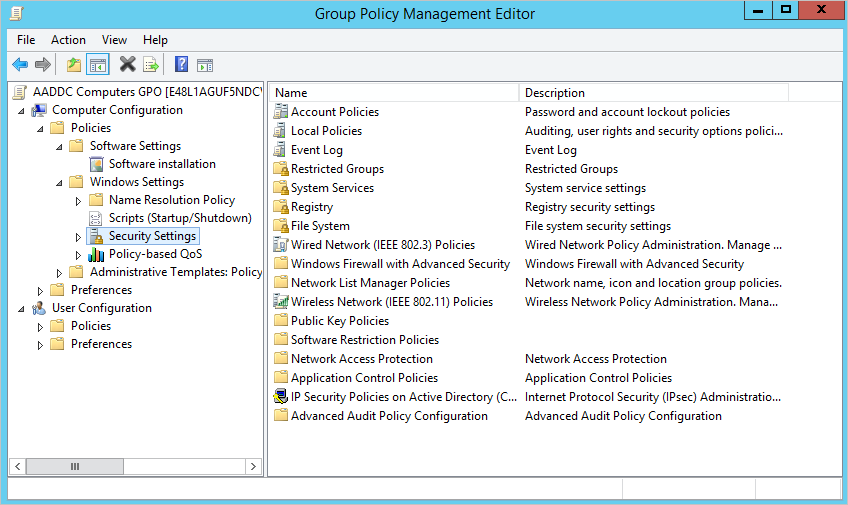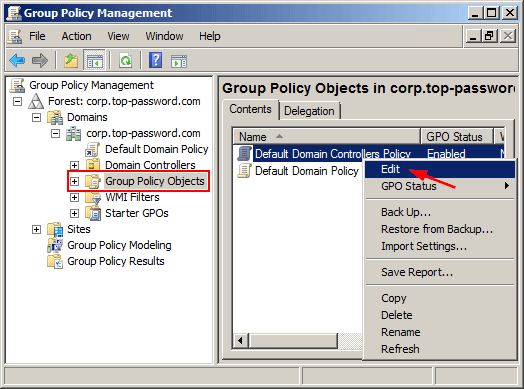- Edit Domain Group Policy Remotely
- Ad Group Policy Editor
- Edit Domain Group Policy Server 2008 R2
- Edit Domain Group Policy Powershell
- Edit Domain Group Policy 2012
- How To Delete Group Policy
- Default Domain Policy Default Settings
In the Group Policy Editor, open the template you just added and change the configuration settings. The most commonly-modified policies are: Set the home page - The URL that Chrome opens when a user launches the browser or clicks the Home button. Edit group policy for domain/AD. By Jefferson6478. On Sep 14, 2016 at 22:46 UTC. Active Directory & GPO. Get answers from your.
How to change Group Policy Settings?
Group Policy is an easy way to configure computer and user settings on computers that are part of the domain. Windows offers a Group Policy management Console (GPMC) to manage and configure Group Policy settings.
Step 1- Log in to the domain controller as administrator
A standard domain user account is not in the local Administrators group and will not have the proper permissions to configure Group Policies.
Steps as follows:
Step 2 - Launch the Group Policy Management Tool
Choose Start → All Programs →Administrative Tools → Group Policy Management
Step 3 - Navigate to the desired OU
Group policy can be applied at domain level, OU level or at a site level. Navigate the forest to the default domain policies.
Step 4 - Edit the Group Policy
Right click on the desired GPO to edit the group policy settings. The group policy management console opens. Every GPO has two basic configurations :
- Computer configuration (applies to computers)
- User configuration (applies to user accounts)
Under each of these configurations are:
- Policies
- Preferences
Choose the configurations you wish to modify, and save them.
Finally, link your GPO to an OU. The group policy settings you have configured will take effect only if you link them to the appropriate container. It could be a domain, site or an organizational unit.
Explore Active Directory auditing and reporting with ADAudit Plus.
- Related Products
Applies to Old versions of flash.
- Windows 10
Looking for consumer information? See Customize the Start menu
Edit Domain Group Policy Remotely
In Windows 10 Pro, Enterprise, and Education, you can use a Group Policy Object (GPO) to deploy a customized Start and taskbar layout to users in a domain. No reimaging is required, and the layout can be updated simply by overwriting the .xml file that contains the layout. This enables you to customize Start and taskbar layouts for different departments or organizations, with minimal management overhead.
This topic describes how to update Group Policy settings to display a customized Start and taskbar layout when the users sign in. By creating a domain-based GPO with these settings, you can deploy a customized Start and taskbar layout to users in a domain. Advanced word repair full version crack download.
Warning
When a full Start layout is applied with this method, the users cannot pin, unpin, or uninstall apps from Start. Users can view and open all apps in the All Apps view, but they cannot pin any apps to Start. When a partial Start layout is applied, the contents of the specified tile groups cannot be changed, but users can move those groups, and can also create and customize their own groups. When you apply a taskbar layout, users will still be able to pin and unpin apps, and change the order of pinned apps.
Before you begin: Customize and export Start layout
Operating system requirements
In Windows 10, version 1607, Start and taskbar layout control using Group Policy is supported in Windows 10 Enterprise and Windows 10 Education. In Windows 10, version 1703, Start and taskbar layout control using Group Policy is also supported in Windows 10 Pro.
The GPO can be configured from any computer on which the necessary ADMX and ADML files (StartMenu.admx and StartMenu.adml) for Windows 10 are installed. In Group Policy, ADMX files are used to define Registry-based policy settings in the Administrative Templates category. To find out how to create a central store for Administrative Templates files, see article 929841, written for Windows Vista and still applicable in the Microsoft Knowledge Base.
How Start layout control works
Three features enable Start and taskbar layout control:
The Export-StartLayout cmdlet in Windows PowerShell exports a description of the current Start layout in .xml file format.
Note
To import the layout of Start to a mounted Windows image, use the Import-StartLayout cmdlet.
You can modify the Start .xml file to include
or create an .xml file just for the taskbar configuration.In Group Policy, you use the Start Layout settings for the Start Menu and Taskbar administrative template to set a Start and taskbar layout from an .xml file when the policy is applied. The Group Policy object doesn't support an empty tile layout, so the default tile layout for Windows is loaded in that case.
Note
To learn how customize Start to include your line-of-business apps when you deploy Windows 10, see Customize the Windows 10 Start layout.

Use Group Policy to apply a customized Start layout in a domain
To apply the Start and taskbar layout to users in a domain, use the Group Policy Management Console (GPMC) to configure a domain-based Group Policy Object (GPO) that sets Start Layout policy settings in the Start Menu and Taskbar administrative template for users in a domain.
The GPO applies the Start and taskbar layout at the next user sign-in. Each time the user signs in, the timestamp of the .xml file with the Start and taskbar layout is checked and if a newer version of the file is available, the settings in the latest version of the file are applied.
The GPO can be configured from any computer on which the necessary ADMX and ADML files (StartMenu.admx and StartMenu.adml) for Windows 10 are installed.
The .xml file with the Start and taskbar layout must be located on shared network storage that is available to the users' computers when they sign in and the users must have Read-only access to the file. If the file is not available when the first user signs in, Start and the taskbar are not customized during the session, but the user will be prevented from making changes to Start. On subsequent sign-ins, if the file is available at sign-in, the layout it contains will be applied to the user's Start and taskbar.

Use Group Policy to apply a customized Start layout in a domain
To apply the Start and taskbar layout to users in a domain, use the Group Policy Management Console (GPMC) to configure a domain-based Group Policy Object (GPO) that sets Start Layout policy settings in the Start Menu and Taskbar administrative template for users in a domain.
The GPO applies the Start and taskbar layout at the next user sign-in. Each time the user signs in, the timestamp of the .xml file with the Start and taskbar layout is checked and if a newer version of the file is available, the settings in the latest version of the file are applied.
The GPO can be configured from any computer on which the necessary ADMX and ADML files (StartMenu.admx and StartMenu.adml) for Windows 10 are installed.
The .xml file with the Start and taskbar layout must be located on shared network storage that is available to the users' computers when they sign in and the users must have Read-only access to the file. If the file is not available when the first user signs in, Start and the taskbar are not customized during the session, but the user will be prevented from making changes to Start. On subsequent sign-ins, if the file is available at sign-in, the layout it contains will be applied to the user's Start and taskbar.
For information about deploying GPOs in a domain, see Working with Group Policy Objects.
Use Group Policy to apply a customized Start layout on the local computer
Ad Group Policy Editor
You can use the Local Group Policy Editor to provide a customized Start and taskbar layout for any user who signs in on the local computer. To display the customized Start and taskbar layout for any user who signs in, configure Start Layout policy settings for the Start Menu and Taskbar administrative template. You can use the Start Menu and Taskbar administrative template in User Configuration or Computer Configuration.
Edit Domain Group Policy Server 2008 R2
Note
This procedure applies the policy settings on the local computer only. For information about deploying the Start and taskbar layout to users in a domain, see Use Group Policy to deploy a customized Start layout in a domain.
Edit Domain Group Policy Powershell
This procedure creates a Local Group Policy that applies to all users on the computer. To configure Local Group Policy that applies to a specific user or group on the computer, see Step-by-Step Guide to Managing Multiple Local Group Policy Objects. The guide was written for Windows Vista and the procedures still apply to Windows 10.
This procedure adds the customized Start and taskbar layout to the user configuration, which overrides any Start layout settings in the local computer configuration when a user signs in on the computer.
To configure Start Layout policy settings in Local Group Policy Editor
On the test computer, press the Windows key, type gpedit, and then select Edit group policy (Control panel).
Go to User Configuration or Computer Configuration > Administrative Templates >Start Menu and Taskbar.
Right-click Start Layout in the right pane, and click Edit.
This opens the Start Layout policy settings.
Enter the following settings, and then click OK:
Select Enabled.
Under Options, specify the path to the .xml file that contains the Start and taskbar layout. For example, type C:UsersTest01StartScreenMarketing.xml.
Optionally, enter a comment to identify the Start and taskbar layout.
Important
If you disable Start Layout policy settings that have been in effect and then re-enable the policy, users will not be able to make changes to Start, however the layout in the .xml file will not be reapplied unless the file has been updated. In Windows PowerShell, you can update the timestamp on a file by running the following command:
(ls ).LastWriteTime = Get-Date
Edit Domain Group Policy 2012
Update a customized Start layout
How To Delete Group Policy
After you use Group Policy to apply a customized Start and taskbar layout on a computer or in a domain, you can update the layout simply by replacing the .xml file that is specified in the Start Layout policy settings with a file with a newer timestamp.
